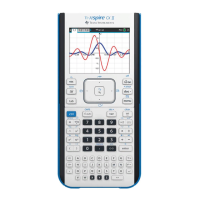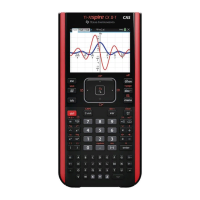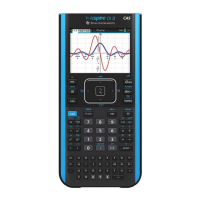34 Working with Documents
A formula is inserted into the cell with var as a placeholder for a
variable name.
3. Replace the letters “var” with a name for the variable, and press
·.
The value is now available as a variable to other applications within
the same problem.
Note: If a variable with the name you specified already exists in the
current problem space, Lists & Spreadsheet displays an error message.
Creating Calculator variables
As alternatives to using h, you can use “:=” or the Define command.
All of the following statements are equivalent.
5+8
3
& num
num := 5+8
3
Define num=5+8
3
Special considerations for variables
Rules for naming variables
Variable and function names that you create must meet the following
naming rules.
Note: Avoid defining variables that use the same names as those used
for statistical analysis. In some cases, an error condition could occur.
Variable names used for statistical analysis are listed in the Appendix of
Functions, under the
StatMatrix entry.
• You can use 1 to 16 characters consisting of letters, digits, and the
underscore character (_). Letters can be U.S. or Greek letters (but not
Π or p), accented letters, and international letters.
• You can use uppercase or lowercase letters. The names AB22, Ab22,
aB22, and ab22 all refer to the same variable.
• The first character cannot be a digit.
• Do not use spaces.
• If you use an underscore as the first character, the variable is
considered a type of unit, such as _m, _ft, and _in. Units do not allow
subsequent underscores in the name.
• You cannot use a preassigned variable or function name, such as ans
or min.
Note: For a complete list of TI-Nspire™ functions, refer to the
TI-Nspire™ Reference Guide.
